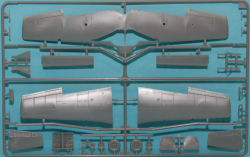
Tamiya 1/48 P-51B Mustang Kit First Look
By Michael Benolkin
| Date of Review | January 2009 | Manufacturer | Tamiya |
|---|---|---|---|
| Subject | P-51B Mustang | Scale | 1/48 |
| Kit Number | 61042 | Primary Media | Styrene |
| Pros | Easy build | Cons | Standard Mustang bugs |
| Skill Level | Basic | MSRP (USD) | $30.00 |
First Look
 |
 |
 |
 |
After North American developed the early Mustangs for the RAF, the USAAC knew that the US was going to be plunged into war and watched the development of this type with keen interest. When the RAF realized that this outstanding fighter was still limited in its performance above 15,000 feet, they re-engined several with the Merlin 61 engine and Rotol four-bladed propeller which gave the Spitfire its performance at altitude. The results were outstanding and North American was soon on the job to upgrade the Mustang.
Designated as P-51B, this new fighter was powered by the Packard-build Merlin engine in its Inglewood CA plant. Parallel production was opened in Dallas TX, with those aircraft designated as P-51C. These new fighters entered the war in 1943 and soon made their presence known to the Luftwaffe.
This was the second Mustang off of Tamiya's 1/48 scale production line following the P-51D. Some might worry that Tamiya recycled parts from the first kit, but that would be an incorrect assumption. While other P-51B kits have had some accuracy issues, this one is just about right.
Molded in light gray styrene, the kit is presented on two parts trees, plus a tree of clear parts. Detailing is all finely scribed throughout.
The cockpit floor is depicted with a curved surface. Many folks (myself included) assume that the P-51B used the upper surface of the wing as the cockpit floor as many other low-wing fighters of this generation did. Once you install the interior in the fuselage and assemble the model, you'd be hard-pressed to tell if that cockpit floor is curved or flat, but if you want it accurate, simply replace the curved section with a sheet of styrene cut to exact dimension and your floor will be flat.
The P-51B had only a slight shift in the leading edge angle at the wing roots to accommodate the landing gear. This angle was much sharper on the P-51D and later Mustangs due to changes in the landing gear design, but you'll see some manufacturers try to use P-51D wings in their P-51B kits. Not so here.
The only real glitch in this kit is the same glitch that plagues all Mustang kits to date - the wheel wells. For whatever reason, manufacturers opt to box in the wells, especially the outboard sections, but the real Mustangs didn't have the edges of the wheel wells boxed in this way. If you look at our photo walk arounds, you can see that the rear of the well is the main spar and this provides maintenance access to the hydraulics and wiring that run through the wings.
The kit has optional wing pylons from which you can hang the metal drop tanks provided in the kit. Among the options with the kit:
- Choice of open or closed canopy
- Optional pilot figure
- Positionable flaps
- Positionable rear radiator flap
- Choice of exhaust stacks
- Optional 108 gallon paper drop tanks
- Optional 500 lb bombs (two)
Markings are included for three examples:
- P-51B-5-NA, 43-6913, 336 FS/4 FG, VF-T, 'Shangri-La', as flown by Capt John Gentile
- P-51B-5-NA, 43-6928, 358 FS/355 FG, YF-I, 'Ole II', as flown by Lt William Hovde
- P-51B-15-NA, 42-106933, 339 FS/504 FG, 5Q-G, 'Bonny Bea', as flown by Capt Lee Eisenhart
The Tamiya P-51 Mustangs are the easiest models to build and render the best results for the least effort. If you want to take a break from some of the more challenging projects 'out there', this is still one of the best kits available to just have fun and still achieve a master's result.







